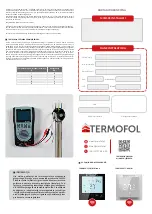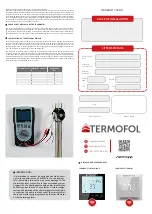
TF-H2 Mark II
The graphic identification of the thermoregulator control panel buttons (display) is presented below.
These buttons are multifunctional, i.e., depending on the operating status of the thermoregulator, and
by varying the duration of holding them down, it is possible to give various commands to the thermore
-
gulator. The description of the buttons and the thermoregulator functions available with their use can
be found below.
OPERATING AND CONFIGURATION MANUAL
OF THERMOREGULATOR TERMOFOL TF-H2 Mark II
CHARACTERISTICS AND TECHNICAL DATA
Thank you for purchasing our product. We hope that you will enjoy using the
TERMOFOL
TF- H2 Mark
II
thermoregulator. It is a fully functional controller of installations and heating devices providing the
highest comfort of use, as well as precise and useful functions that will allow you to fully control the
climate in your rooms. The display of the thermoregulator and its basic technical parameters are pre
-
sented below.
power consumption < 3 W • supply voltage: 230 V AC 50/60 Hz • maximum amperage of switching current: 20A •
programmable temperature range 1+99 °C • factory range of programmed temperature.: 5+35 °C • internal air tem
-
perature sensor accuracy: ±0.5 °C • protection class IP20 • external floor temperature sensor: NTC • manual control •
possibility of programming • mounting method: surface • color: white • dimensions: 86 mm x 86 mm x 37 mm
TERMOSTAT INSTALLATION, ELECTRIC CONNECTIONS
The TF-H2 Mark II is a modern, programmable thermoregulator equipped with LCD control panel in
-
tended for controlling electric heating systems. The thermoregulator reads the temperature from the
built-in sensor and external temperature sensors, which is included in the kit along with the thermore
-
gulator. Prior to its installation, disassembly, cleaning, inspection or change of the configuration, always
disconnect the thermoregulator from the power source, e.g., by switching off the power line in the elec
-
tric switchboard. Read the entire contents of this manual before installing the thermoregulator. In the
territory of the Republic of Poland, the electric connections of the thermoregulator should be made by
an electrician holding a valid SEP license for electric installations up to 1 kV.
The electric installation supplying the thermoregulator should meet the requirements specified in the
Regulation of the Minister of Infrastructure and Construction on technical conditions to be met by buil
-
dings and their location (Journal of Laws of 7 June 2019, item 1065) along with the reference standards.
Fig. 3 Example of thermoregulator location
The installation of the thermoregulator should be planned in a place not exposed to direct sunlight.
Figure 2 shows the thermoregulator terminal strip used for making electrical connections of the device
to the electric network. The cables must be connected as indicatedthe given scheme. After completing
the installation and making electrical connections, check the system figuration in accordance with the
next section of this manual.
CONTROLLING – DESCRIPTION OF THE FUNCTIONS OF THECONTROL BUTTONS
–
+
DISPLAY ICONS – SPECIFICATION
No.
Symbol
Setting item
Parameter setting function
Factory
default
1
SEN
Sensor control option
0: internal sensor
1: external sensor
2: internal control temperature and
external limit temperature
2
2
OSU
Limit temperature value of
external sensor
5–99 °C
28 °C
3
dlF
Return difference of limit
temperature value of exter
-
nal sensor
1–9 °C
2 °C
4
SUH
Set upper limit temperature
value
5–99 °C
35 °C
5
SUL
Set lower limit temperature
value
5–99 °C
5 °C
6
AdJ
Measure temperature
–5÷5 °C
0,0 °C
7
FrE
Anti-freezing function (only
for water heating)
00: anti-freezing function close
01: anti-freezing function open
00
8
POn
Power on memory
00: Power on no need memory
01: Power on need memory
00
9
FAC
Factory default
08: no change
00: factory reset
08
sensor
1,2m
The thermoregulator is designed for surface
mounting.
1.
Remove the black sheet on the back of the
thermoregulator (by moving it down) and
screw it to the wall.
1
2
3
4
2.
Unload the flap on the back of the thermo
-
regulator.
3.
Make the connection of the wires accor
-
ding to the diagram and screw the flap.
Fig. 4
Fig. 5
Fig. 6
1. Terminal for connecting for phase wire of thermoregulator power supply
2. Terminal for connecting the neutral wire of thermoregulator supply
3. Terminal for connecting the neutral wire of the controlled receiver (heating mat, heating foil)
4. Terminal for connecting the phase wire of the controlled receiver (heating mat, heating foil) supply
5, 6. Terminals for connecting the external temperature sensor NTC (polarity is irrelevant)
Fig. 2
Fig. 1
4.
Mount the thermoregulator on the wall.
Fig. 7
Power ON/OFF button
This button is used to change the operating mode from automatic to manual. Pressing this button
for about 5 seconds allows you to set the thermoregulator work schedule.
Touching this button allows you to set the current time and day of the week.
Increasing cursor button. Repeated touches increase the value of the set temperature.
Decrease cursor button. Repeated touches decrease the set temperature value.
When the thermoregulator is operating in the automatic schedule mode, the b/- allow for a
temporary temperature correction in respect of the current period of the automatic schedule of the
performed by the thermostat.
manual mode
operating mode
active air
sensor
active external
sensor
day of the week
time
set temperature
current temperature
6 heating periods
in the automatic
schedule mode
SETTING THE OPERATING SCHEDULE
When the thermoregulator is on, press the button for about 5 seconds. Then with +/– select schedu
-
le mode (5+2, 6+1 or 7). Then set the desired temperature for the six periods heating. Presses to
move to the next period. Also repeat the schemefor weekend days.
Period
Icon
Default
Period Time
Default
Period Temperature
Working Day
1
06:00
20 °C
2
08:00
15 °C
3
11:30
15 °C
4
12:30
15 °C
5
17:30
22 °C
6
22:00
15 °C
Weekend
1
08:00
22 °C
2
23:00
15 °C
ADVANCED SETTINGS
To go to the advanced settings, turn off the thermoregulator. Then you should press - and the button on
/ off. To go to the next parameter, press . Values are changed with + and –.
+
–






















